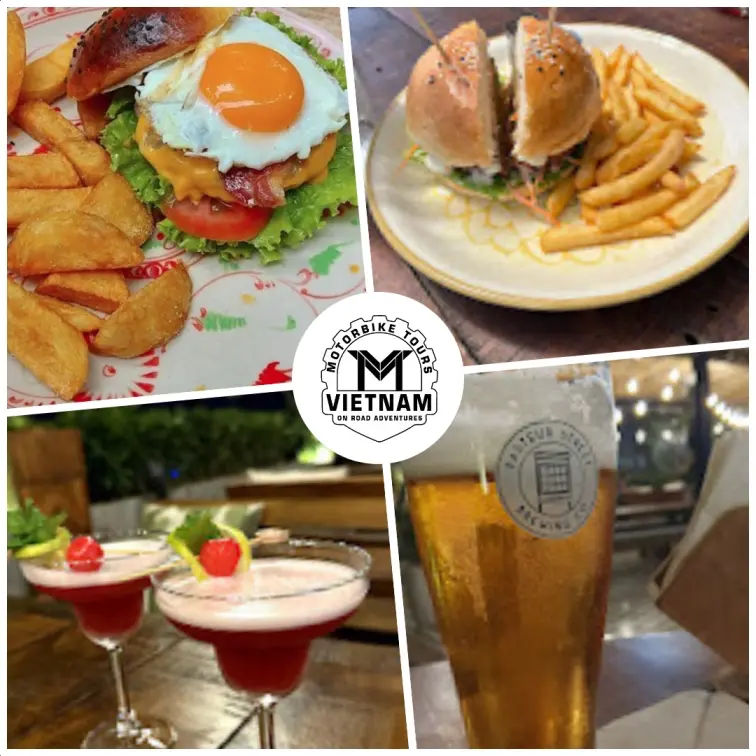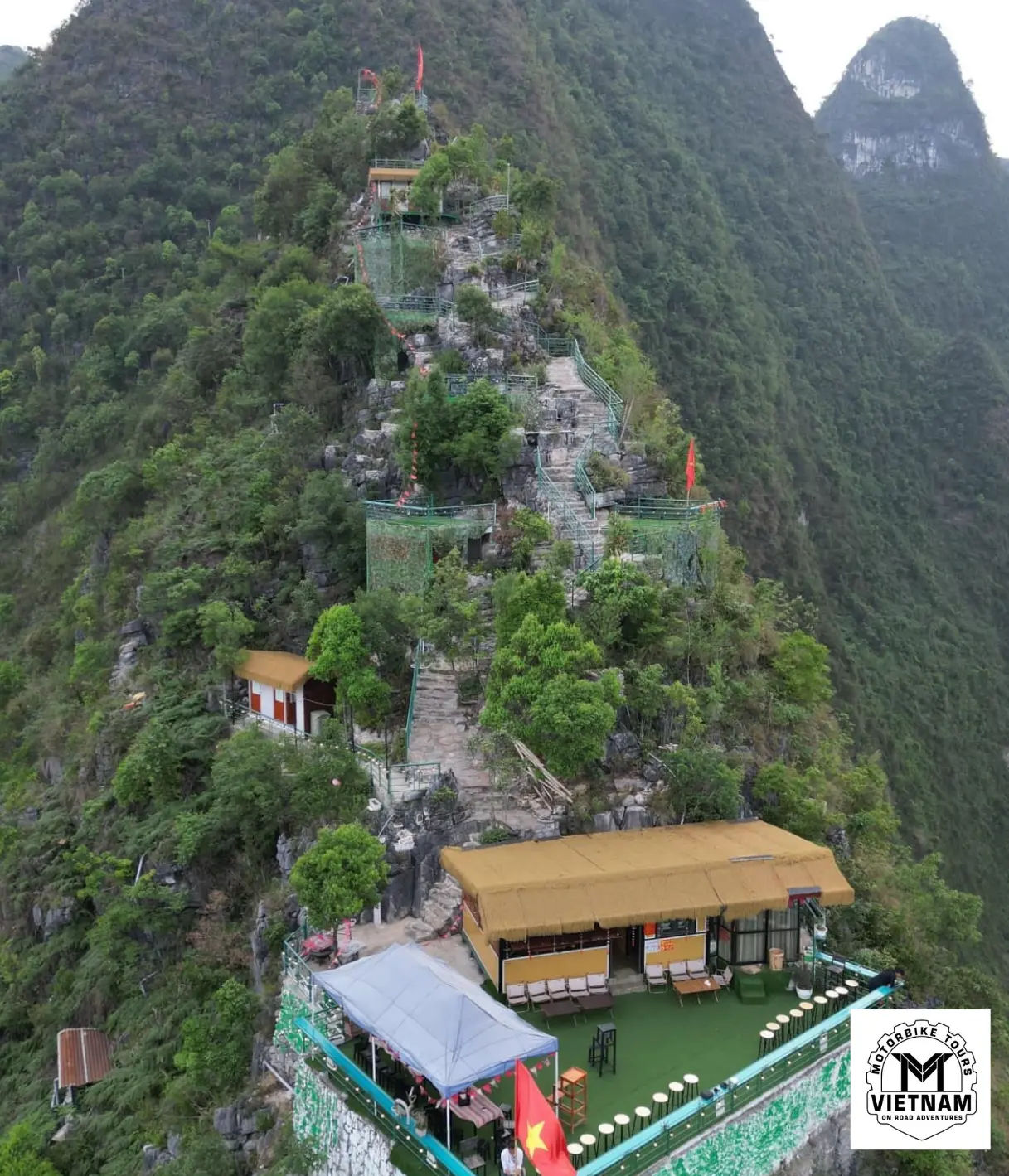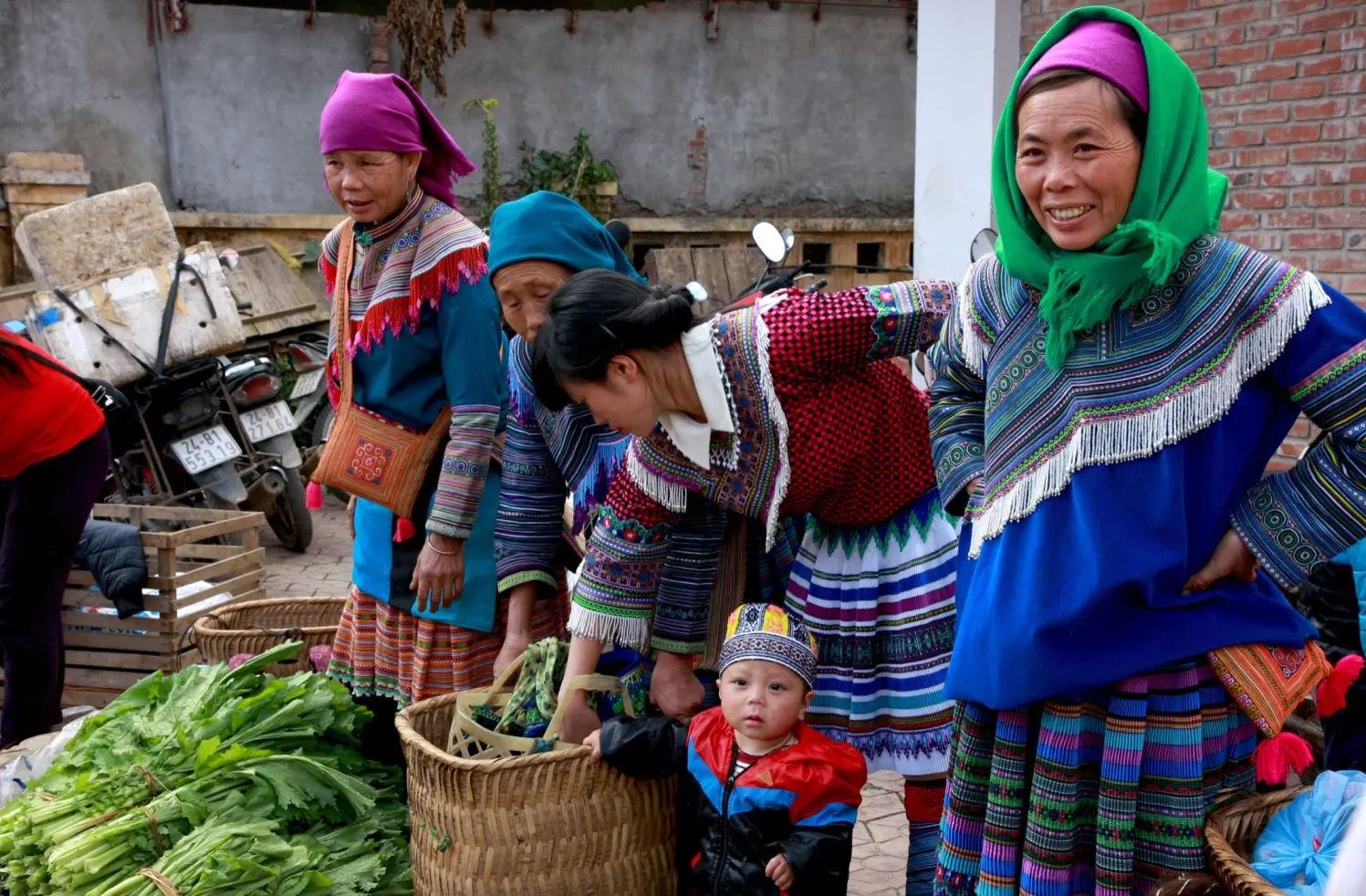
Internet is full of information and about an A to Z stuff for the infamous Ha Giang Loop but not many share about where and what to tat along the Ha Giang Loop. Your adventure should be a chance to enjoy surprisingly good cuisines along the way. You’ll find everything from local dishes to relaxed cafés with unbelievable jaw dropping views. Favorites include Pao Kitchen, Ma Pi Leng Restaurant near the famous pass, and Hao Tea House for vegetarian travelers.
For more variety, spots like Mr. Hung Bar Restaurant, Rosco’s Restaurant & Bar, Green Hill Restaurant, and Blue Sky Restaurant serve hearty meals, smoothies, and some Western options. Don’t miss the local specialty Au Tàu porridge, a medicinal dish carefully cooked to remove toxins. And if you’re craving something different, you can even find pizza along the route.
- Check out Best Vietnam motorbike Tours
A Quick look on Where & What To Eat Along The Ha Giang Loop
| Dish | Description | Where to Try |
|---|---|---|
| Au Tàu Porridge | A medicinal porridge made from a toxic bulb carefully prepared to be safe and nourishing. | Homestays and local restaurants along the loop |
| Thắng Cố | Hearty stew made from horse meat or other local meats, traditional northern flavors. | Street markets in Ha Giang, Dong Van |
| Grilled River Fish | Fresh trout or river fish, grilled with herbs and served simply to highlight natural flavor. | Local Vietnamese restaurants along the route |
| Sticky Rice Cakes | Sweet or savory cakes made from glutinous rice, often sold at markets or small cafés. | Street markets, Dong Van, Meo Vac |
| Mountain Herb Salads | Fresh local herbs mixed with vegetables and occasionally light protein, served as a side or appetizer. | Family-run homestays and local restaurants |
Introduction to Ha Giang Loop and Its Culinary Scene
Last week I spent eight days tracing the high, serrated ridges of the Ha Giang and northern frontier areas and quickly realized the region’s food scene is as much a highlight as the views.
Meals here are honest and slow-cooked: bowls of steaming broth arrive with fragrant herbs plucked that morning, grilled meats come wrapped in banana leaf smoke, and roadside stalls offer sticky rice shaped by practiced hands.
What surprises most is the variety from humble kitchens serving mountain-style Vietnamese fare to small cafés tucked into guesthouses where you can enjoy a strong Vietnamese coffee while clouds drift past. Locals take pride in their ingredients: wild greens, river fish, and the curious Au Tàu porridge, a medicinal dish carefully prepared to make a poisonous bulb safe.
Food is social here; you’ll find conversations with other fellow riders over late breakfasts, traders sharing plates mid-ride, and hosts insisting you try one more helping before you go.
Top Restaurants Along Ha Giang Loop
On my route I kept a running list of places that deserved the repeat visit sticker, Pao Kitchen for dependable comfort food, Ma Pi Leng Restaurant for its dramatic perch near the pass, Hao Tea House for calm vegetarian plates, plus evening haunts like Bar Restaurant and Rosco’s where travellers lingered over beer and conversation.
Blue Sky and Green Hill stand out for casual all-day menus and generous portions that hit the spot after a long day’s travel. What ties these spots together is a relaxed, unhurried service: expect sympathetic smiles, dishes served family-style, and the occasional English menu at the busier places.
Many kitchens will cook for specific tastes if you ask; I watched a chef adapt a pork dish to be milder for an older guest with ease. If you’re chasing specialties, ask about Au Tàu porridge or the region’s grilled river fish; guides and hosts usually know who does the best version. Nights are when the restaurants feel most alive, with local families sharing tables and visitors swapping routes and tips, great for striking up conversation and discovering a hidden dish through recommendation.
- Check out Most scenic routes along the Ha Giang Loop
- Go premium and check out our Motorbike tours on a BMW GS
Local Vietnamese Restaurants
Local Vietnamese restaurants in Ha Giang are where regional cooking comes into sharp focus, unpretentious, ingredient-led and framed by the seasons. I remember a midday stop in a low-slung eatery where the owner ladled out bowls of clear broth teeming with mountain greens, slices of tender pork, and rice noodles that tasted of yesterday’s dough.
Flavours lean towards the rustic: smoky, slightly fermented condiments, bright coriander, and the peppery bite of fresh chillies. These places often specialise one serves only broken rice and slow-roasted pork, another concentrates on simple noodle soups and fried river fish.
Service is efficient but warm; you’ll eat among locals, farmers and the odd trekking guide, watching a steady stream of deliveries arrive from the closest market. Prices are modest and portions generous enough to share a few starters. For an authentic tasting experience, try to arrive midday when dishes come out fresh and hot, ask the owner what’s best today, they’ll tell you without hesitation, and usually point you to a memorable, home-style plate.
- Check out Off-road Vietnam
Family-Run Homestay Kitchens
The homestay kitchens are the real heart of Ha Giang’s culinary identity. I stayed one night with a family on a terraced hillside Lo Lo Chai Village, where the lady owner herself cooked over a wood-fired stove and served dinner at a communal table under a single hanging bulb.
Food here is personal: recipes handed down for generations, with an emphasis on seasonal produce and resourcefulness. Expect shared platters of sautéed wild greens, fermented soy or fish sauces, and a pot of porridge or stew simmered until each flavour has settled into place. Hosts are proud to share dishes like Au Tàu porridge, explaining the care taken to render the bulb harmless, and watching that process gives you a real appreciation for the technique and patience involved. Meals in homestays are social events; strangers often leave as friends, having swapped travel stories and scooped up extra helpings of a house speciality.
If you want authenticity, book a homestay meal and arrive hungry, the portions are generous, the welcome genuine, and the conversation often the best part of the night.
Fine Dining Options with Scenic Views
Ask yourself first, am I visiting the ethnic minority heart of Vietnam to eat western foods? Well, so many western tourist does, you might as well. and for this, there are few places in Ha Giang city offer a fair grade of western foods, burgers, pizza, western beer and good cocktails.
For a change of pace, there are a handful of restaurants that lift the meal into an occasion, pairing thoughtful plates with panoramic views. I ate at a terrace restaurant just below a ridge and remember the way the light softened as the team served a composed fish dish and a selection of salads that used local herbs in unexpected ways.
These places refine local ingredients rather than reinvent them: mountain goat transformed into a delicate ragout, trout plated with pickled vegetables, or a tasting plate of small bites showcasing regional produce. Service is attentive without being formal staff will explain where each ingredient came from and how it was prepared.
The real draw, though, is the setting: large windows or open terraces that put the landscape on equal billing with the food. They’re where you go to linger over a slow lunch, map your next day and enjoy a glass of something chilled while the clouds move across the valley. If you want to celebrate a particularly good day on the Loop, reserve a table at sunset, the view becomes part of the meal and the flavour hangs on longer because of it.
Best Cafes Along the Route
Cafes along the Ha Giang Loop aren’t just places to refuel, they’re small pauses in the journey where you can catch your breath, watch clouds drift across the valleys, and sip something warm while the mountains settle around you.
Last week, I found myself stopping far more often than planned, drawn in by wooden balconies, the smell of roasted beans, or a simple hand-painted sign promising tea with a view.
Some cafés sit right along the roadside, busy with travellers; others are tucked behind homestays or hidden on quiet lanes where only locals seem to wander. What struck me most was how unhurried these stops felt. Whether it was a cup of strong Vietnamese coffee, a herbal tea brewed from the owner’s garden, or a smoothie blended from seasonal fruit, each break added a small moment of calm to the long winding days. If you like slow afternoons and gentle scenery, Ha Giang’s café culture is an easy place to get comfortable.
Mountain View Cafes in Dong Van
Dong Van has a habit of surprising you with cafés perched in places you wouldn’t expect, narrow balconies hanging over stone alleys, terraced rooftops facing the karst peaks, or tiny shops where you sip coffee while children play on the street below.
One of my favourite afternoons was spent in a café tucked above the old quarter, where the walls were lined with old photographs and the air carried the smell of freshly ground Robusta.
As I watched the sun shift across the cliffs, the owner brought over a pot of honey tea and pointed out which peaks were visible that day. These cafés blend charm with practicality: good Wi-Fi if you need it, quiet corners for reading, and strong coffee that cuts through early morning chill. Many offer small snacks — sticky rice, fried yam, or simple pastries, which pair well with a hot drink after exploring Dong Van’s market. If you arrive between late morning and mid-afternoon, you’ll catch the soft light that makes the whole town feel suspended in time.
Coffee Spots in Meo Vac and Yen Minh
Meo Vac and Yen Minh deliver a different kind of café experience, understated, friendly, and often run by families who greet you like an old neighbor. In Meo Vac, I stopped at a modest shop near the main road, drawn in by the sound of beans tumbling in a small roaster. The owner served me a smooth cà phê sữa đá and chatted about the weekend market while his kids did homework at the next table.
That’s the rhythm here: simple, intimate, and comfortably local. Yen Minh, by contrast, has cafés that feel airy and open, with large windows framing rolling pine hills. They’re great stops for early mornings — hot coffee, fresh air, and a gentle quiet that lingers before traffic picks up. Some places even serve herbal drinks made from plants gathered in nearby forests. If you’re travelling between these towns, keep an eye out for small roadside cafés; the unplanned stops often become the most memorable ones.
Hidden Cafes Loved by Locals
The hidden cafés are the ones you usually hear about through a passing comment — a guide mentions a place his cousin runs, or a shopkeeper points down a side path and says, “Good tea there.” I followed one of these recommendations and ended up in a small stilt-house café set back from the road, where the only sounds were distant cattle bells and the soft whistle of boiling water.
The couple who ran it served coffee grown on their family’s small plot and poured me a cup that tasted earthy and slightly sweet. These spots aren’t polished; they’re personal.
The seating might be a wooden bench, a mountain breeze acts as the air-conditioning, and the menu is simply whatever the family has on hand that day. But that’s the charm — you’re stepping into someone’s world for a moment. If you enjoy quiet places away from the main route, ask around at your homestay or any local shop. You’ll be surprised how many wonderful little cafés are hidden just a few minutes off the road, waiting with a warm drink and a slower pace.
Must-Try Dishes and Local Specialties
Many people asking me, What to eat in Ha Giang and northern Vietnam that feels a true local cuisine? The food in Ha Giang feels deeply tied to the land, every plate reflects the altitude, the weather, and the traditions that have shaped the region for generations.
During my last trip, I found myself slowing down at every meal just to savor the details: the smoky aroma from meat grilled over open charcoal, the gentle bitterness of mountain herbs, and the warmth of broths that felt made for cool mornings. Dishes here aren’t flashy, but they’re full of character. You’ll see bowls of rice noodles topped with local greens, crispy corn cakes sold at markets, and comforting stews that simmer from midday until night.
And then there are the specialties: the carefully prepared Au Tàu porridge, famous for its medicinal properties; hearty thắng cố stews; and grilled river fish that tastes like it came straight from the stream. Eating in Ha Giang is less about checking dishes off a list and more about trusting small kitchens and homestays to show you what the region does best.
Traditional Northern Vietnamese Cuisine
Northern Vietnamese cuisine in Ha Giang or other areas in general, carries a rustic honesty that’s hard to find elsewhere. Meals often start with something simple, a bowl of broth clear enough to see the herbs floating in it or rice noodles with just the right chewiness.
The flavors are layered but not overpowering: ginger, lemongrass, peppercorns, and a generous scattering of fresh greens. During my visit, I kept returning to cơm tấm plates served with caramelized pork and pickled vegetables, each bite balanced and comforting.
Markets serve bánh cuốn made on hot steamers, rolled and ready within seconds, and mornings often begin with bánh mì filled with pâté and a dash of spicy chili sauce. What stood out was the freshness, vegetables picked that morning, broth simmered for hours, fish bought right from the riverbank. If you enjoy Vietnamese food elsewhere, Ha Giang’s version feels like discovering the source: familiar flavors preserved in their purest, most local form.
Unique Highland Ingredients and Flavors
The highlands lend Ha Giang a pantry that you won’t find anywhere else in Vietnam. Wild herbs grow along terraces and forest edges, giving dishes a fragrant, mountain-sharp aroma that chefs in major cities try to imitate but rarely match. I tasted greens with a minty bitterness that paired perfectly with pork, and mushrooms gathered from shaded slopes that gave soups an earthy depth.
Corn shows up everywhere in wine, cakes, porridge, and even in fried street snacks sold at weekend markets. Highland spices tend to be more subtle; they warm rather than burn, making room for the natural taste of vegetables and meat.
The most intriguing ingredient is the Au Tàu bulb, toxic when raw but transformed into a nourishing porridge through hours of careful preparation. You’ll also find dishes made from free-range chicken, mountain goat, and river trout, all lighter, cleaner tasting, shaped by the environment they grow in. Exploring these flavors feels like exploring the region itself: rugged, honest, and quietly complex.
Tips for Food Lovers Traveling the Ha Giang Loop
If food is part of your travel story, Ha Giang rewards curiosity. Start by eating early — many kitchens prepare their best dishes for breakfast and lunch, and once they sell out, that’s it for the day.
Don’t hesitate to ask what’s fresh; owners are usually eager to recommend a dish they’re proud of. Homestays often serve some of the most memorable meals, so consider staying in places known for their cooking and let your hosts guide the menu.
Street markets are ideal for snacking your way through local flavors: grilled corn, sticky rice, steamed cakes, and herbal teas appear throughout the day. Carry small cash, as many family-run spots don’t take cards. And be open to dishes you’ve never heard of especially regional specialties like Au Tàu porridge or grilled mountain herbs. The loop is long, and food breaks become some of the trip’s highlights, offering warmth, rest, and a taste of the highlands’ slow rhythm.
Conclusion: A Culinary Journey Through the Mountains
Ha Giang’s mountains aren’t just a feast for the eyes, they’re a haven for the taste buds. From rustic northern dishes and wild highland herbs to hidden cafés and homestay meals, every stop offers something authentic and memorable. Each bite tells a story of the land, the people, and generations of cooking, making the Ha Giang Loop a journey that lingers long after the last plate is cleared.
About the Author
Hamid is an avid rider, adventure seeker, and passionate foodie who has explored the winding roads and hidden culinary gems of Vietnam’s northern highlands. Combining a love for travel with a taste for local flavors, he shares firsthand experiences and practical tips for fellow travelers looking to discover authentic food and culture along scenic routes like the Ha Giang Loop.













